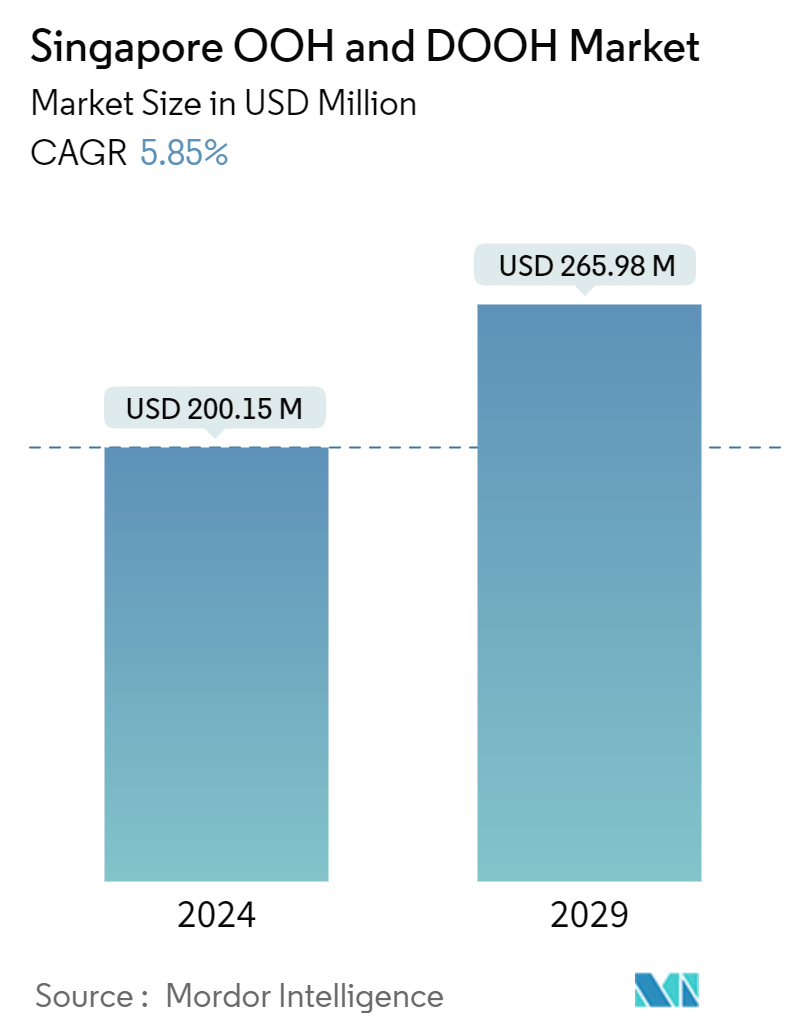Market Size of Singapore OOH And DOOH Industry

| Study Period | 2019 - 2029 |
| Base Year For Estimation | 2023 |
| Market Size (2024) | USD 200.15 Million |
| Market Size (2029) | USD 265.98 Million |
| CAGR (2024 - 2029) | 5.85 % |
| Market Concentration | Medium |
Major Players
*Disclaimer: Major Players sorted in no particular order |
Singapore OOH and DOOH Market Analysis
The Singapore OOH And DOOH Market size is estimated at USD 200.15 million in 2024, and is expected to reach USD 265.98 million by 2029, growing at a CAGR of 5.85% during the forecast period (2024-2029).
- Singapore continues to invest in urban infrastructure, new locations, and formats for OOH and DOOH advertising, which is expected to facilitate more opportunities for advertisers. According to the Smart City Index 2023 by the Institute for Management Development (IMD), a Swiss business school, Singapore ranked as the fifth smartest city globally and holds the title of Asia's smartest city.
- Smart city initiatives leverage a variety of digital displays to enhance urban operations, with each display offering potential revenue streams through advertisements. Digital signage technology plays a pivotal role in monetizing these opportunities. Ranging from compact interactive kiosks to expansive digital billboards, these systems provide robust computing capabilities, advanced graphics, and seamless connectivity. They not only leave a lasting impact but also provide crucial analytics for informed decision-making.
- According to the Building and Construction Authority of Singapore, the public sector is expected to increase the construction demand in 2024. As per projections, a range between USD 13.3 billion (SGD 18 billion) and USD 15.6 billion (SGD 21 billion) is required, with a primary focus on public housing and infrastructure initiatives. The projects that are set for 2024 include the Housing and Development Board's (HDB) new Built-To-Order (BTO) developments, infrastructure works for the future Changi Airport Terminal 5 (T5), and other projects. Thus, OOH advertising can be used in such areas to drive consumer engagement toward the brand.
- There is a growing shift from traditional to digital format, with DOOH becoming a significant part of advertising in Singapore due to its dynamic and real-time capabilities. High-traffic areas like MRT stations, bus stops, and shopping malls present a prime location for out-of-home and digital-out-of-home advertising, reaching a large and diverse audience.
- Digital screens and high-tech installations require regular maintenance to ensure they function correctly and provide high-quality displays. Moreover, ensuring return on investments from OOH and DOOH campaigns can be challenging, especially compared to online advertising with clear metrics. These factors are restricting the market’s growth.
- After the COVID-19 pandemic, the OOH and DOOH market in Singapore witnessed growth, which facilitated the advertisers with dynamic content changes, enabling them to quickly adapt their messages to current events or changing circumstances. As more people visit public areas, shops, and transportation centers, advertisers are becoming increasingly interested in outdoor and digital outdoor advertising. They see this as a way to increase their revenue by using dynamic advertising.

